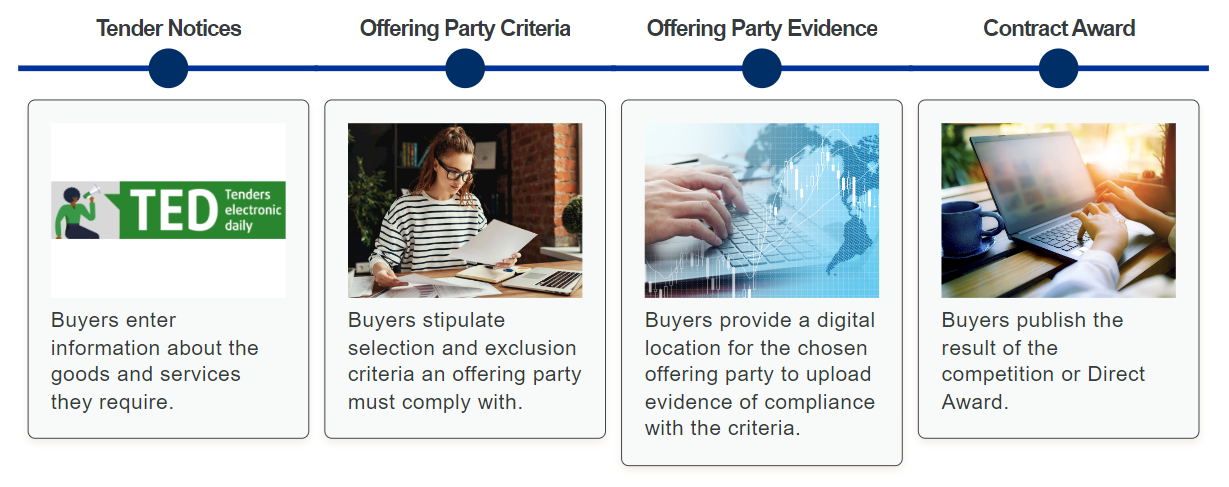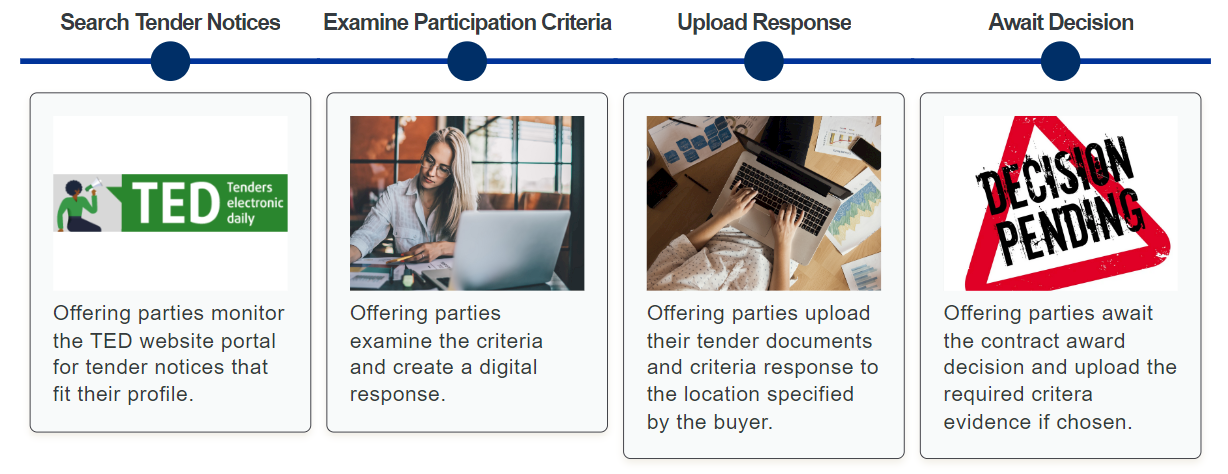The European Single Procurement Document
An Introduction for Business Users
The European Single Procurement Document (ESPD) is a electronic form used by buyers to assess the suitability of offering parties in a public procurement procedure. Statements and evidence (documentation to support the statements) that are provided by offering parties against EU, national, and procedure specific criteria, are managed via the ESPD.
The first part of the form, the ESPD Request, enables buyers to state the selection criteria offering parties have to meet, and what evidence of lawfulness and integrity they must provide, for their tender to be considered by the buyer. The second part of the form, the ESPD Response, enables offering parties to respond, and to list the evidence they can provide to substantiate their response.
The main objective of the ESPD is to reduce administrative burden by removing the need to produce large numbers of physical certificates and documentation related to exclusion and selection criteria. The intention is to make participation in public procurement less burdensome for small and medium-sized enterprises (SMEs).
The three main phases of the public procurement process are:
-
Pre-tendering, which includes the preparation and planning of the procedure;
-
Tendering, which includes:
-
The publication of the contract notice by the Contracting Authority (CA) or buyer;
-
The submission of tenders by the offering parties;
-
The opening of tenders;
-
The qualification of offering parties by applying the exclusion grounds and selecting suitable tenderers based on the selection criteria set by the CA during the preparation of the procedure and published in the contract notice;
-
The evaluation of bids, based on the award criteria set by the CA;
-
The award of the contract.
-
-
Post-tendering, or contract implementation.
The ESPD is specifically concerned with qualification of offering parties step above.
The ESPD Process from a Business Perspective
The ESPD process for a buyer

The ESPD process for a offering party

Legal framework
The Public Procurement Directive 2014/24/EC Article 59 (the "Directive") introduced the concept of the European Single Procurement Document (ESPD). By mapping out equivalent certificates between Member States, the ESPD replaces certificates issued by public authorities, or a third party involved in a procedure. It greatly simplifies and levels out cross-border participation by a greater number of operators in public procurement, and contributes to integrating the European Single Market.
The ESPD Service enables buyers and offering parties to create, edit, export and import electronic documents in XML format (eESPD) for the exchange of criteria, requirements, statements and references regarding eligibility to participate in public procurement. Article 4 of the Directive regulates in detail public procurement procedures in which the value of the contract exceeds a certain amount. These amounts, also known as 'thresholds', vary depending on the type of the contract, and the administrative level of the Buyer. Those contracts that fall under article 4 of the Directive are called contracts 'above the threshold', and the rest are known as contracts 'below the threshold'. The ESPD Service is flexible enough to provide coverage to procurement procedures both above and below the threshold.
As in the image below, the first version of the digital ESPD was released in 2016 (version 1.0.1). Since then, a number of new developments and enhancements have been made to the ESPD Service, taking into account Member States' requirements and needs in compliance with the Directive.
Figure 1: ESPD-EDM Roadmap
The evolution of the ESPD developed in alignment with eForms. The alignment followed three main principles:
-
Ensuring the interoperability between models;
-
The simplification of data processing;
-
Facilitating fulfilment of the ESPD for both Buyers and Economic Operators.
Currently, the European Commission does not maintain an ESPD service; it is up to Member States to implement the latest ESPD version available.
The ESPD-EDM
As already mentioned, there are two ESPD parts or documents making up the ESPD:
-
The Request document, which is used by Buyers (Contracting Authorities) to express the selection criteria and exclusion grounds, and any other requirements, that the Economic Operators must fulfil in the context of a tender;
-
The Response document, which is used by Economic Operators to answer the questions and provide references to evidence in response to the criteria and requirements expressed by the Buyer in the Request document.
The ESPD Service is oriented therefore to these two types of users:
-
Buyers or Contracting Authorities, who are state, regional or local authorities, bodies governed by public law or associations formed by one or more of such authorities, or one or more such bodies governed by public law (as defined in Article 2 of the Directive);
-
Offering parties or Economic Operators, who are any natural or legal person or public entity or group of such persons and/or entities, including any temporary association of undertakings, who offer the execution of works and/or a work, the supply of products, or the provision of services on the market (as defined in Article 2 of the Directive).
Economic Operators can play different roles, catered for in the ESPD-EDM, within a procurement procedure:
-
Sole Tenderer: sole economic operator participating in the procurement procedure by itself;
-
Group Member: In case of a Consortium, Joint Venture or other types of groups, the economic operator can participate as a:
-
Group Leader: the leader of the group: the Group Leader is the point of contact with the buyer and speaks on behalf of the group with the buyer.
-
Group Member (not leader) of the group: a group member supplies a percentage of the contract.
-
Other entity (relied upon): An entity upon which the main contractor, the group, or another subcontractor, relies on order to meet the selection criteria;
-
Subcontractor: An entity upon which the main contractor, the group, or another subcontractor, does not rely on order to meet the selection criteria, not a group member.
-
The effect of Lots
Important to note is that ESPD forms must be filled in per lot:
-
The exclusion grounds automatically apply to all lots.
-
The selection criteris apply per lot i.e., they may be different between lots.
Each section is filled in by one or both parties, and in the case of a response involving a offering group, the group leader must fill in information related to group members in their response: names and other identifying details, AND each party must fill in and sign an ESPD. It is the Group leader’s responsibility to collect the completed ESPD Response documents from all parties per lot and submit them in the tender.
The process is illustrated in the diagram below:

| Different EO parties might have different roles in different lots, hence the requirement for each participating party to fill in one ESPD Response per lot. |
A table of which EO role should fill in which sections in the ESPD Response is provided in the ESPD parts description below.
Parts of the ESPD
Each section of the ESPD form is filled in by one or both parties, and in the case of a response involving a offering group, the group leader must fill in information related to group members in the response.
Part 1: Buyer and procedure information
The Buyer fills in:
Information concerning the procurement procedure and the Buyer or contracting entity, where the Buyer is required to provide information about the publication, the identity of the procurer, and the procurement procedure.
The offering party fills in:
Information concerning the procurement procedure and the Buyer or contracting entity, where the offering party is required to identify the ESPD Request to which it is creating a response, by providing information about the publication, the identity of the procurer, and the procurement procedure.
Part 2: Offering party information
| The Buyer does not fill in this section. |
The Offering parties fill in:
Information concerning the economic operator, where they are required to provide:
-
Information about the economic operator;
-
Information about representatives of the economic operator;
-
Information about reliance on the capacities of other entities;
-
Information concerning subcontractors on whose capacity the economic operator does not rely.
Part 3: Mandatory information on Exclusion Grounds (required by law)
The Buyer fills in:
Exclusion grounds, where the Buyer is required to review
-
Grounds relating to criminal convictions;
-
Grounds relating to the payment of taxes or social security contributions;
-
Grounds relating to insolvency, conflicts of interests or professional misconduct;
-
Purely national exclusion grounds that apply to the procurement procedure
| The Offering parties must respond to all the above questions. |
Part 4: Selection criteria
The Buyer indicates which selection criteria will be applied to the offering party:
-
suitability;
-
economic and financial standing;
-
technical and professional ability;
-
quality assurance schemes and environmental management standards
The offering party responds to each of the above criteria.
Part 5: Reduction of qualified candidates
| The buyer does not fill in this section. |
The offering parties provide information where the buyer or contracting entity has specified objective and non-discriminatory criteria or rules, in part 4, to be applied. This serves to limit the number of candidates invited to tender, or to take part in a dialogue within a two-phased procedure.
Part 6: Concluding statements
The offering parties declare that the information submitted under Parts 2 - 5 is accurate and true, that is able to provide certificates and/ or other forms of documentary evidence listed, for verification, and consents to grant the buyer access to where the documentary evidence is stored.
The information required in the response document from economic operators depends on their role. This is summarised in the table below:
| Table 1 | Sole Tenderer / Group Leader | Group Member | Other Entity relied upon | Subcontractor |
|---|---|---|---|---|
Part 1 Identify ESPD request and other procurement information |
X |
X |
X |
X |
Part 2 Information about the economic operator |
X |
X |
X |
X |
Information about representatives of the economic operator |
X |
X |
X |
X |
Information about reliance on the capacities of other entities |
X |
|||
Information concerning subcontractors on whose capacity the economic operator does not rely |
X |
|||
Part 3 Exclusion grounds |
X |
X |
X |
X |
Part 4 Selection Criteria |
X |
X |
X |
|
Part 5 Reduction of the number of qualified candidates |
Adhoc |
Adhoc |
Adhoc |
|
Part 6 Concluding statements |
X |
X |
X |
X |
Table 1: Information to provide in the ESPD Response per role
It is not necessary for Buyers and Economic Operators to create an ESPD document from scratch for each procedure. ESPD documents can be downloaded, edited, and reused in further procurement procedures, making filling in the form much more efficient.
Goals and benefits of the ESPD
The main goals and benefits of the ESPD are to:
-
ensure compliance with EU and national procurement regulation.
-
reduce the administrative burden;
-
harmonise and optimise selection criteria;
-
support and foster the development of the Digital Single Market;
-
foster cross-border participation in procurement, increasing competition and supporting economic growth together with other models or initiatives (like eCertis);
-
provide transparency and clarity about the evidence requested;
-
facilitate participation in public procurement;
-
facilitate the participation of small and medium-sized enterprises (SMEs) in public procurement.
Any comments on the documentation?